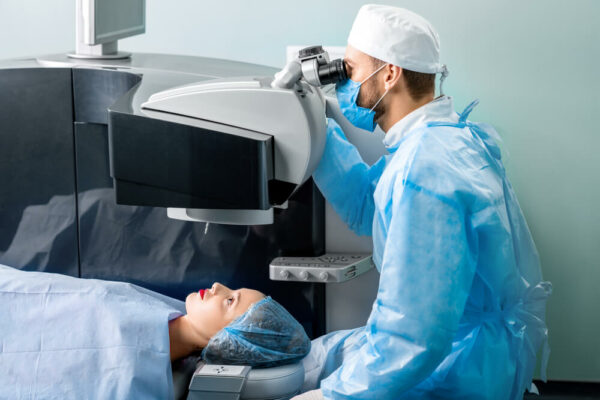

Like most people, you probably find yourself having to take reading glasses on or off to see at various distances, and this can be inconvenient and cumbersome. Because life requires being able to see at far and near, you likely have several pairs of reading glasses, perhaps in every room of the house! Or perhaps you are wearing a bifocal or trifocal that limits your field of vision and near and mid-range.
Today’s refractive cataract surgery now allows you to have many choices in the types of lenses that can be implanted during cataract surgery, and among them is an extended depth of focus intraocular lens implant (IOL). Some examples of this lens include the Tecnis Symfony® IOL, Alcon Vivity® and many more in development. Unlike monofocal (standard) IOLs that allow you to see at only one distance, the Extended Depth of Focus (EDOF) IOL is designed to allow improved vision at various distances. EDOF IOLs typically provide excellent distance acuity with added intermediate and in some cases near vision. These IOLs accomplish this by lengthening your focal range, resulting in an increased depth of focus to your vision at various distances. Although you might still prefer to wear reading glasses for prolonged reading, most patients electing an EDOF IOL will find that they do not depend upon glasses for daily activities such as driving, watching television, using a cell phone or computer. Medicare and other insurance providers will cover all or part of surgery utilizing a traditional IOL, but they will require you to pay the difference in cost between a standard IOL and extended depth of focus IOL. This will be explained in more detail at the time of your consultation.
The extended depth of focus implant, such as the Symfony IOL, uses technology similar to that used in the highest quality, professional-grade camera lenses. This technology reduces what is known as chromatic aberration.
The Symfony IOL is also available in a toric (astigmatism) IOL option, which allows for correction of astigmatism in addition to nearsightedness or farsightedness.
Depending upon the pupil size and type of EDOF lens used, you may experience halos, glare, or starbursts around lights at night. These halos are much different than the ones created by cataracts, and are often a well accepted trade off to the improved range and clarity of vision. As the brain adapts they typically become less noticeable and bothersome. This process is called neuroadaptation, and how quickly it happens depends upon the individual. In most instances, neuroadaptation occurs over the span of several months, but as the brain makes these automatic adjustments to how your vision is processed, almost all patients report continued improvement with the quality of vision over time.

Missouri Eye Institute-Springfield at Bradford Place Surgery and Laser Center utilizes a femtosecond laser on premises to provide laser-assisted cataract surgery for all types of cataract surgery. This laser platform allows the surgeon to create 3-D imaging of your eye, which provides more accurate information and treatment choices during your cataract removal. The laser’s advanced technology allows the surgeon to use precisely-placed laser pulses to effectively soften the cataract for removal. It helps to ensure the most appropriate condition for the best lens placement, which ultimately helps to restore your vision to its fullest potential. Additionally, the laser can be used to aid in the correction of astigmatism, an eye condition that causes the curvature of the front of the eye (cornea) to not be perfectly round which causes images to be out of focus. The femtosecond laser can be used to correct minor to moderate amounts of astigmatism by creating incisions to relax the curvature of the cornea, thereby reducing or eliminating astigmatism. The femtosecond laser can be used with any types of IOL implants and can be discussed with your surgeon.
Missouri Eye Institute performs cataract surgery at surgical centers in Springfield, Branson, and Joplin, and provides cataract surgeries at hospitals in Springfield, Bolivar, Monett, and Houston to make your care as convenient as possible. We can also coordinate your care after cataract surgery with your local optometrist in order to make the post-operative care convenient for you.
Springfield
1531 E Bradford Parkway Ste 100
Springfield, MO 65804
Branson
1000 James F. Epps Rd Ste 2
Branson, MO 65616
Joplin
4500 E 32nd St
Joplin, MO 64804